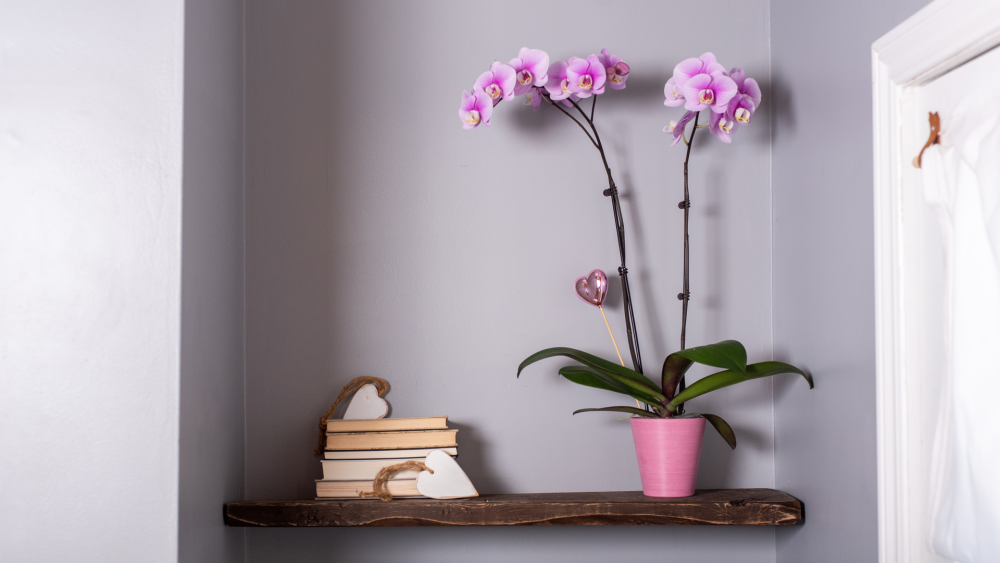
People have long adored orchids for their beauty and unique appearance. The beautiful flowers come in a variety of colors and shapes, bringing elegance to any indoor space.
Orchids may appear difficult to care for initially. However, with proper care, they can thrive and bloom indoors all year. If you're new to caring for orchids or want to improve your skills, this guide can help. It covers everything you need to know about caring for these lovely plants inside your home.
Moth orchids, also called Phalaenopsis orchids, are popular with beginners plant owners. They are resilient and can adapt well to indoor environments.
Adequate light is crucial for orchids to thrive indoors. Position your plant in a spot where it can get bright, diffused sunlight, close to a window facing east or west. Avoid placing them in direct sunlight, as this can scorch their delicate leaves. If natural light is limited, consider supplementing with artificial grow lights specifically designed for orchid's with a full color spectrum output.
Orchids prefer temperatures between 15-25ºC (59-77ºF) (room temperature) during the day and slightly cooler temperatures at night. Avoid exposing them to drafts or extreme temperature fluctuations, which can stress the plant. They also thrive in environments with moderate to high humidity levels, around 50% to 70%. To increase humidity for your plant, place a tray filled with water and/or pebbles beneath the pot or use a humidifier in the room that it is in.
Proper watering is perhaps the most critical aspect of orchid care. Excessive watering can result in root decay, whereas insufficient watering can trigger dehydration and hindered development.
During the growth period, water your plant fully, ensuring excess water is able to flow out of the bottom of the pot or to dump the excess water after it has had a chance to absorb what it needs. You can expect to water your plant every 7 - 21 days.
However, let the top inch of the plants soil to dry before watering. During the dormant period, typically in winter, reduce watering frequency to prevent waterlogged soil. Also when watering into a pot without drainage holes, be sure to discard any excess water as this can lead to root rot or increase the chances for pests.
Also be sure to give your orchid room temperature water as water that is too cold or too hot can damage your plant and its roots. Also avoid getting any water on its blooms.
Orchids require a specialized potting soil that provides excellent drainage while retaining moisture. A blend of orchid bark, sphagnum moss, and perlite is commonly used to create an airy, well-draining soil for its roots. Repot your orchid every one to two years to refresh the potting medium and prevent the buildup of salts and minerals.
When re potting, inspect the plants roots and trim off any rotted or damaged roots. If root rot is present, you can dilute a mixture of water and hydrogen peroxide (no more than a 3% concentration) and spray the roots before re potting to kill off any lingering bacteria.
To encourage healthy growth and abundant blooms, fertilize your orchid regularly during the growing season. Use a balanced orchid fertilizer diluted to half strength and apply it every two weeks. Reduce or cease fertilization during the dormant period to allow the plant to rest. Be sure to follow the direction on the bottle of fertilizer and adjust as needed.
Remove spent flower spikes and dead or yellowing leaves promptly to maintain the overall health and appearance of your plant. Use sertile, sharp scissors or pruning shears to make clean cuts. Additionally, provide support for tall or top-heavy orchid stems using stakes or clips to prevent them from bending or breaking.
Yes your orchid can re bloom again! To encourage your orchid to rebloom, provide it with plenty of indirect sunlight, proper watering, and balanced fertilization. Additionally, trim back old flower spikes and maintain a consistent temperature and humidity level for optimal growth.
You can also re pot your orchid before it re blooms. This will allow you to inspect its roots and remove any root rot, or damaged roots. This will increase your chances of your orchid re blooming successfully!
Yes, most orchids are generally considered safe for pets, including popular varieties like Phalaenopsis orchids (moth orchids). These beautiful plants are non-toxic to cats and dogs, making them a pet-friendly choice for your home or office.
However, while orchids are non-toxic, pets that nibble on them may still experience mild stomach upset due to the plant material itself. To keep both your plants and pets safe, it’s a good idea to place orchids out of reach, as curious pets might still knock them over or damage the flowers.
If you're unsure about a specific orchid variety, it’s always wise to double-check with a trusted resource, such as the ASPCA or your veterinarian.
Keep a close eye on your plant for signs of pests such as aphids, mealybugs, or spider mites, as well as common fungal diseases like root rot or powdery mildew. If detected, promptly treat the affected plant with appropriate organic or chemical remedies to prevent further damage.
Caring for orchids indoors can be rewarding. It allows you to enjoy the beauty of these flowers year-round.
It can also be fulfilling. With proper attention to light, temperature, humidity, watering, and fertilization, your orchid will thrive and delight you with its stunning blooms for years to come. So go ahead, embark on your orchid-growing journey and discover the joy of cultivating elegance in your own home.